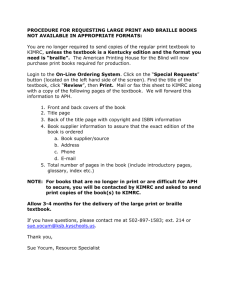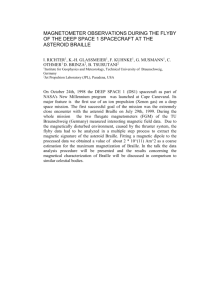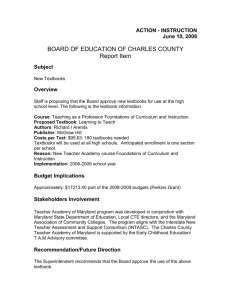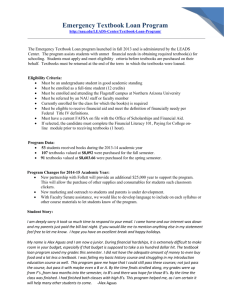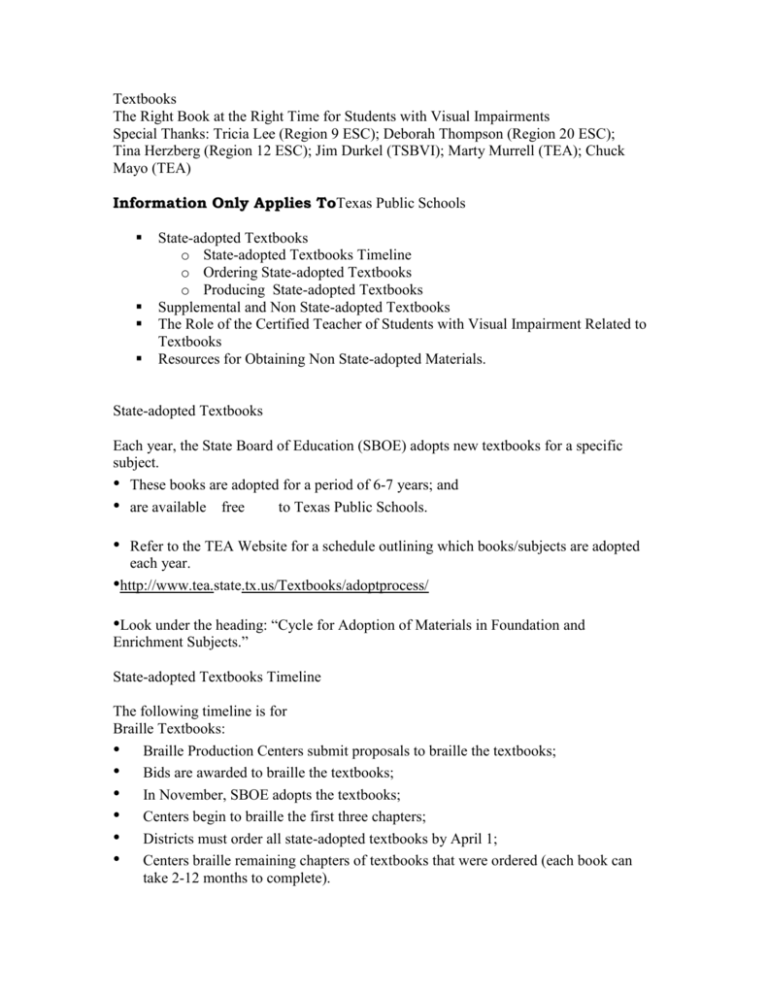
Textbooks
The Right Book at the Right Time for Students with Visual Impairments
Special Thanks: Tricia Lee (Region 9 ESC); Deborah Thompson (Region 20 ESC);
Tina Herzberg (Region 12 ESC); Jim Durkel (TSBVI); Marty Murrell (TEA); Chuck
Mayo (TEA)
Information Only Applies ToTexas Public Schools
State-adopted Textbooks
o State-adopted Textbooks Timeline
o Ordering State-adopted Textbooks
o Producing State-adopted Textbooks
Supplemental and Non State-adopted Textbooks
The Role of the Certified Teacher of Students with Visual Impairment Related to
Textbooks
Resources for Obtaining Non State-adopted Materials.
State-adopted Textbooks
Each year, the State Board of Education (SBOE) adopts new textbooks for a specific
subject.
• These books are adopted for a period of 6-7 years; and
• are available free
to Texas Public Schools.
•
Refer to the TEA Website for a schedule outlining which books/subjects are adopted
each year.
•http://www.tea.state.tx.us/Textbooks/adoptprocess/
•Look under the heading: “Cycle for Adoption of Materials in Foundation and
Enrichment Subjects.”
State-adopted Textbooks Timeline
The following timeline is for
Braille Textbooks:
• Braille Production Centers submit proposals to braille the textbooks;
• Bids are awarded to braille the textbooks;
• In November, SBOE adopts the textbooks;
• Centers begin to braille the first three chapters;
• Districts must order all state-adopted textbooks by April 1;
• Centers braille remaining chapters of textbooks that were ordered (each book can
take 2-12 months to complete).
Adoption is done the same way for large print textbooks. Bids for producing large print
editions are solicited and contracts awarded by TEA. Request for large print editions of a
text are sent to the contracted producer.
Audiotape textbooks are ordered
directly from the Recording for the
Blind and Dyslexic and not through TEA. Recording for the Blind and Dyslexic
do not have a specific time frame for placing orders, but they do recommend that school
districts order audiotapes as soon as they know which titles the student will need.
Ordering State Adopted Textbooks
The district’s Textbook Coordinator submits orders to TEA electronically using the
EMAT On-line Annual Requisition or via paper.
Directions for ordering can be found in the Textbook Coordinator’s Manual on the Web
at: http://www.tea.state.tx.us/Textbooks/materials/tcmanual.html
Information specific to books for students with visual impairments is located in the
“Special Textbooks for Special Students” chapter of the Textbook Coordinator’s Manual.
http://www.tea.state.tx.us/Textbooks/materials/man4.htm#gg
Before ordering remember that the following requests cannot be made electronically:
• Request for texts in un-contracted braille (grade 1); and/or
• If the Coordinator is willing to accept incomplete texts and receive partial orders of
individual chapters as they are put into braille, he/she must make the request when
ordering and again this cannot be done electronically.
After district orders are received:
• TEA compares the textbook request for large print and braille with the Annual
Registration of Students with Visual Impairments.
• If the order information is consistent, the order is processed; if the order is not
consistent, then the order is set aside until the difference can be resolved.
To avoid major delays, make sure that accurate information is provided on both the
Registration and the textbook order. Contact Chuck Mayo, Assistant Division Director,
Textbook Administration and Director for Accessibility, Textbook Administration, if you
know the information will not be consistent (for example, a student moved into your
district after the Registration’s January deadline).
Chuck Mayo Contact Information:
Phone: (512) 463-9601
Fax: (512) 463-9501
E-mail: cmayo@tea.state.tx.us
Producing Newly State-adopted Textbooks
After orders are approved and processed by TEA:
•
•
TEA passes the orders to the Braille/Large Print Production Centers.
The Centers shift their brailling priorities from doing a few chapters of all the books to
completing the books that have been ordered.
Remember that districts that are able to turn in their orders before the April 1 deadline
have a better chance of having their books ready by the first day of school.
Usually by the end of the next full school year, the centers are able to have all the
previous year’s adoption brailled. The challenge is to have all the books ready by the first
school year, which is especially problematic for math and high-level science books.
Remember math & high-level science books take longer to braille because:
• Unlike literary books, graphs, charts, etc., are not available in electronic format; and
• There is a critical shortage of transcribers with the special expertise and certification to
produce these textbooks.
When large print & braille textbooks are completed The centers send the textbooks to the
districts with the addresses provided by TEA.
Remember this usually occurs during the summer and the books will be stored until
school begins.To avoid the misplacement of textbooks delivered over the summer, the
district should have a written procedure on how books in alternate format will be
processed and how the certified teacher of the visually impaired and campus
administration will be notified.
When braille and large print textbooks are not delivered on time:
• Contact the Textbook Coordinator at the TEA Textbook Division.
• Determine the problem
• Find a remedy
Remedies might include:
• Partial shipments of the completed volumes;
• Overnight delivery
Districts can help to ensure that state-adopted textbooks will be available on time by:
having the school board, campus administrators, textbook coordinators, classroom
teachers, parents, and the certified VI teacher work together.
The following suggestions have been provided to make this happen…
Suggestions
• When the district is choosing the textbooks to adopt locally, consider the needs of
the students who require braille/large print.
• Be aware, several years in advance, of the schedule of subjects/books being adopted.
If using higher-level math or science textbooks, develop a graduation plan so the student
will not require one of these books the first year of adoption.
•4.If at all possible, especially if the adoption involves higher-level math/science books,
delay the adoption of the new textbook for one year. This will allow the state time to
produce these difficult to braille books.
•5.Schedule local adoptions as soon as possible after the November SBOE adoption, so
that the alternate format editions can be ordered well in advance of the April 1 deadline.
•6.Submit alternate format textbook orders to TEA as soon as the student’s needs for the
following year are known, well in advance of the April 1 deadline.
•7.Accurately complete the Annual Registration of Students with Visual Impairments
which must be submitted to the School for the Blind and Visually Impaired in January.
•8.Develop and implement written procedures for early identification and ordering of
needed braille/large print textbooks.
•9.Develop and implement written procedures for handling braille/large print books when
they are delivered to the district, including notifying the student’s certified VI teacher and
campus administrator.
•10.Develop and implement written procedures for reporting late books to the Textbook
Coordinator, and if necessary, to TEA.
•11.The local VI teacher should develop a relationship with the local/district textbook
coordinator.
Supplemental Materials & Non State-adopted Materials
The following materials are NOT available from the State at no cost to the district:
• Non state-adopted textbooks;
• State-adopted texts used as supplemental texts; and
• Supplemental materials such as workbooks and ancillary readers.
It is the district’s responsibility to make all supplemental and non state-adopted textbooks
or materials available in braille/large print/books on tape.
Before Ordering
If there is a braille/large print/audio reader who will be in the course:
• Require those who make textbook decisions to include the availability and cost of the
alternate format editions as one of the criteria for choosing the textbook.
Determine if the book is available for purchase or loan in the alternate format.
•Determine if it is possible to translate the book into the alternate format. (This can take
many months.)
•Anticipate and budget for these costs or build in procedures that can help minimize the
cost.
•Review a number of books that will meet the needs of a particular class to see if at least
one will be affordable and possibly available.
STOP- Remember it can be very expensive to have a book brailled, especially for math,
science, foreign languages, and other advanced level books. Some braille versions of
texts can cost as much as $20,000 each.
The average braille costs can run $2 to $5 per page, depending on braille codes used and
the need to develop tactile graphics.
To reduce cost and production time, it is important for the VI teacher to be aware of
available resources. These resources can:
• Help determine if the book is already in the alternate format.
• Let the districts know which method of obtaining the book is the most cost effective.
The district’s regional education service center can provide technical assistance and
training about available resources.
When negotiating with publishers for the supplemental or non state-adopted textbooks,
the district should require the publisher to:
• Provide literary textbooks in an electronic file format that meets at least the minimal
requirements of the TEA for the state-adopted books.
This may reduce time and cost of producing the book in braille/large print.
Important
It is the district’s responsibility to:
• Ensure that a quality textbook is produced in braille/large print/audio, with no errors
and with appropriate formatting.
• Ensure graphs, charts, diagram, tables, and maps are addressed either through
transcribers notes and/or quality tactile graphics.
• Ensure that only a highly trained and certified braille transcriber approves the
formatted text.
Please Note: It is not cost effective or appropriate to use a certified vision teacher to
braille a textbook.
Although a VI teacher can read, write, and teach braille, typically the teacher will not
have the specific training or skills or time necessary to produce braille textbooks.
It is also inappropriate to use unskilled paraprofessionals who use braille translation
software as the only means of producing the books.
Without specific training, an unskilled paraprofessional WILL NOT be able to produce
appropriate tactile diagrams that must supplement the textThe Result… If anyone other
than a highly trained and certified braille transcriber is used, the result may be a product
with errors and inappropriate formatting.
Remember…enlarging a textbook on a copy machine is not an appropriate way to
produce large print textbooks. Important information such as color in diagrams and charts
may be lost. Contrast and clarity of print may be compromised.
14. The local district arranges to have the materials brailled by: local transcriber,
contract transcriber,
ESC-if they offer this service, or
The district is responsible
for any costs.
APH ATTIC http://www.aph.org/atic/atic.htm3. Is the book a stateadopted textbook?
http://www.tea.state.tx.us/Textbooks/materials/bulletin/
5. Search the online
APH Louis database at http://www.aph.org/louis.htm
Is the book listed in the APH Louis database as available in either embossed
format
or in file format?
23. Check other listings of
previously brailled books
e.g. NLS database Web-Blind at http://www.loc.gov/nls/webblnd/advancedsearch.html
TSBVI downloadable braille material links at
www.tsbvi.edu/braille/index.htm22.The local district arranges to have the
materials brailled by:
Local certified transcriber,
Contract transcriber,
ESC-if they offer this service, or
VI teacher (if caseload allows).
The district is responsible
for any costs.
oAPH ATTIC http://www.aph.org/atic/atic.htmThe district can ensure that the adapted
textbooks will be available on time by following the provided suggestions:
Suggestions
•
Establish and follow written procedures for determining how textbooks will be
chosen for general education courses that include criteria such as availability and
cost of alternate format books.
• Follow the “TEA Textbook Decision Tree” to determine the most cost effective
method of obtaining an edition of a book.
3.Establish and follow written procedures for contracting with individual transcribers or
braille production centers when books are not available. Include requirements such as
certifications, experience, references, etc.
4.When possible, seek a transcriber who can use the publisher’s electronic file.
5.Be familiar with prevailing cost for braille transcription.
6.Provide local transcribers opportunities for professional development at the local, state,
and national level.
7.Address the district and regional need for transcribers through the Regional Plan for
Students with Visual Impairments coordinated by the education service center.
8.If the district has a high and ongoing demand for braille production, employ certified
transcribers for the district.
9.If transcribers are not available, recruit and train individuals to become certified
transcribers.
10.Develop an appropriate pay scale and career ladder that reflects the high level skills
involved.
11.Meet with the education service center regarding training for braille transcribers.
12.Determine the courses students who need alternate formats will be taking as early as
possible to produce the materials on time. (Remember some high school textbooks can
take up to a year to produce in braille.)
The Role of the Certified Teacher of Students with Visual
Impairments Related to Textbooks
The certified VI teacher is a key member of the district team that helps ensure students
who need alternate format books have the right book at the right time.
This team will minimally include:
• Textbook Administrator
• Classroom Teacher
• Special Education Director
• Campus Administrator
• VI Teacher
• Student (in some cases)
• Student’s Parents (in some cases)
To meet the challenge of getting the right book at the right time, each district will
develop:
• Policies,
• Procedures,
• Roles, and
• Responsibilities.
The VI Teacher has the knowledge and skills to:
• Conduct the Learning Media Assessment to determine if the student needs braille/large
print.
• Teach the student to read using braille code.
• Teach some student(s) to use optical devices to read regular print books.
• Report textbook delays, errors, etc., to appropriate administrators within the district or,
if necessary, with the TEA for timely follow-up.
Work with the student’s classroom teacher to determine which materials need to be
adapted in braille/large print/audio.
Work with appropriate campus administrator, early, to determine the student’s schedule
for the following year to determine what materials need to be adapted.
Begin working in the Spring semester with teachers who will be teaching the student
next year to determine reading media needs.
Work with the appropriate campus administrators to determine which textbooks will be
available in adapted format from the State and which the district must provide.
Work with textbook decision makers to help reduce unanticipated high braille cost.
Help recruit and obtain training for district-employed transcribers.
Provide guidance and direction to the district transcribers to meet the unique needs of
the students who use braille.
Provide input to appropriate district administrators regarding contracting with qualified
transcribers to produce textbooks.
Provide direct input into the Registration of Students with Visual Impairments to ensure
it is accurate.
Provide input to the Textbook Coordinator regarding any unique braille requirements
(i.e., contracted vs. uncontracted) for specific students, to ensure that the orders for braille
state-adopted textbooks are accurate.
Provide input related to this issue in the development of the Regional Plan for Services
to Students with Visual Impairments, which is coordinated by the ESC.
Verify that the textbooks received from the State or from other sources are timely,
without errors, and in appropriate format.
Resources for Obtaining Non State-adopted MaterialsAccessible Media
Producers Database (AMP):
The AMP database includes the names, locations, and qualification of producers of
accessible materials for visually impaired and blind individuals.
Contact Information:
Accessible Media Producers Database (AMP)
American Printing House for the Blind
1839 Frankford Avenue
Louisville, KY 40206
Phone: 502-895-2405
Fax: 502-899-2274
Email: resourcs@aph.org
Web: www.aph.org/ampdb.htm
Louis Database of Accessible Materials:
A list of contributing agencies to the Louis Database of Accessible Materials, many of
which produce materials in braille, can be accessed via the APH website.
Contact Information:
Louis Database of Accessible Materials
American Printing House for the Blind
1839 Frankford Avenue
Louisville, KY 40206
Phone: 502-895-2405
Fax: 502-899-2274
Email: resourcs@aph.org
Web: www.aph.org/louis.htm
Accessible Textbooks Initiative and Collaboration Project (ATIC):
The goal of ATIC is to provide accessible textbooks in braille and other media to students
who are visually impaired in as effective a manner as possible.
Contact Information:
Accessible Textbooks Initiative & Collaboration Project (ATIC)
American Printing House for the Blind
1839 Frankford Avenue
Louisville, KY 40206
Phone: 502-895-2405
Fax: 502-899-2274
Email: atic@aph.org
Web: www.aph.org/atic/index.html
Additional Websites
International Electronic Book Library http://www.braille.org/ National Library Service
for the Blind and Physically Handicapped (NLS)
http://www.loc.gov/nls Computers
to Help People, Inc. http://www.chpi.org/Texas School for the Blind and Visually
Impaired: http://www.tsbvi.edu/braille/index.htmThis production has been made
possible by funding from: TEA via decentralized projects for students
with visual impairments at ESC Region XIAll Rights Reserved: Any
portion of the production may be reproduced for educational or
personnel development purposes only. For any other uses please
contact TSBVI Outreach Program at (512) 206-9270.

